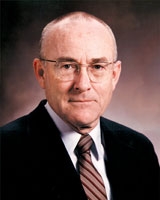Henry McGill, Jr.
Year: March 21st, 2001
Location: San Antonio, Texas
Interviewed by: Labarthe, Darwin
Abstract
This is the story of the inspiration for the International Atherosclerosis Project and the early systematic observations on atherosclerosis and its fatty streak precursors in the autopsies of children and youth, studies that established the youth onset and progression of complicated atheromata as well as cross-cultural differences in adult arteries, along with the worldwide comparable prevalence of fatty streaks in youth. This classic study was the vision of Henry McGill, with the systematic discipline and long term view of McGill and Strong, of a geographic pathology, the pathologist’s version of epidemiology. The early influence of Jerry Morris as consultant to this unique group is new information to us. It also describes the beginnings of the more elaborate study of the development of atherosclerosis in youth: P-DAY, by Wissler and colleagues. More is found in the oral history from Jack Strong. (Henry Blackburn)
Quotes
Grading Lesions
He [Russell Holman at LSU] started talking about atherosclerosis being a pediatric disease. He got us to go over to the big Charity Hospital [of New Orleans] which did 2,000 autopsies a year in those days and pick up aortas of mostly children not older people, [up to] about [age] 25-30. We had them stained and he got us started grading these. And we thought it was kind of crazy, but we went along with him; at that time the big mysteries were the fat extremes in children. And whether the arterial lesions were the major clinical phenomenon, because you see so much stroke in our population. We were questioning whether it was the atherosclerosis or something else that led to heart attacks.’
An Epiphany
When asked about the start of the International Atherosclerosis Project, IAP, McGill told this story:
That kinda got started by a fellow by the name of Aaron Goldworth of Boston. We had collected 100 vessels, aortas, and coronary arteries from New Orleans autopsies including a lot of accidents. At one time, 1954 or ‘55, Aaron Goldworth came to New Orleans and he graded hundreds of these. Then he went down to Guatemala and he had made contact with a pathologist at INCARE, Instituto de nutricion de centro america . . that was run by a fellow by the name of Nevin Scrimshaw (who then later went to MIT. Very well known). He [Goldworth] graded a bunch of arteries down there and then he wrote a paper about atherosclerosis: U.S. vs Guatemala, using our material. And that pissed us off royally!
But then we got in touch with Carlos Tejada and he turned out to be a very nice gentleman. He visited New Orleans and we talked about making a better comparison of the lesions in Guatemala and New Orleans and then that was all talk. In 1957 I went to Colon, Columbia on sabbatical for a year with the support of LSU and the Rockefeller Foundation to work in [Cali]… one of the South American medical schools that Rockefeller was trying to support…
This was motivated by a missionary urge… And the practice there in South American is like a 2-hour siesta in the middle of the day and we lived about 2-3 miles from the medical school so it was easy to drive home, have lunch, and take a nap. One afternoon I woke up from a nap with the idea that we ought to do this kind of survey right. We ought to organize and study and collect arteries. A lot of different places recording with standardized methods and just do it right.
So I started to talk about that, came back to New Orleans next year, 1958, wrote up a proposal. We, Jack Strong did most of the work with me on that, and Carlos Tejada, the fellow in Guatemala, Scrimshaw was a big help… Holman was not very interested in it. I think he wanted to get me out of the nest.
Findings of the IAP
One was the ubiquity of the findings among all children, all humans about the age of three or four. There was a fatty streak in the aorta, coronary arteries. The origin of the fatty streaks I think has never been explained by the scavenger receptor… But the observation then was that fatty streaks in the aorta appeared in all the children, all humans, but in varying degrees in the coronary arteries.
The second major observation was that the fibrous plaque in the more advanced lesions, calcification [coincided with] reported prevalence and incidence of coronary heart disease in populations. Those are the main things.
Progress
I think most of the progress from the 70s on has been in cellular and molecular biology… So far as I can think of right now, none of that has led yet to anything practical or useful, although it may at any time. For example, Dan Steinberg’s oxidized LDL and everybody took it up and did lots of work on that. And that led to the big step of the epithelial role in the generation of nitric oxide, epithelial dysfunction. And now it’s molecular biology I can’t even follow.
Full Transcript Access
Full transcripts of interviews may be made available to those engaged with original materials for scholarly studies by contacting us.
